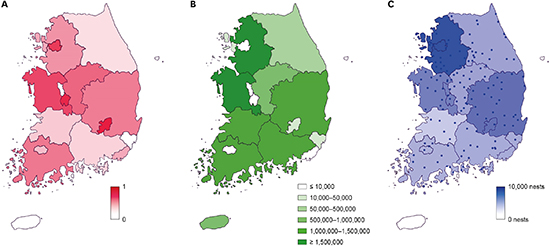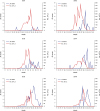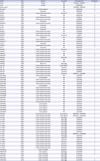Japanese encephalitis virus (JEV), member of Flaviviridae, causes Japanese encephalitis (JE) in human. JEV has transmission cycle including birds as reservoirs, pigs as amplifying hosts and
Culex mosquitoes as vectors. Among
Culex mosquitoes,
Culex tritaeniorhynchus is primary vector, and other mosquitoes can transmit JEV between host vertebrates. JEV has only one serotype but it has I–V genotype depending on envelope gene sequences.
1 About 1,600 cases were reported annually until the 1970s but only 10 cases were reported annually after the introduction of JE vaccine and mandatory vaccination program for children 3–15 years of age in the 1980s in Korea.
2 However, average 20 cases were reported nation-widely and the trend of reporting number of JE cases are increasing since 2010.
3 We analyzed changes of characteristics of reported JE cases in recent several years and suggest birds as potential factors affecting to epidemiology of JE cases.
In 2011 to 2016, total 131 cases including 17 deaths were reported in Korea. Seventy-five cases (57.3%) were male and 56 cases were female (42.7%). By age group, 38.9% were aged 50–59 years, 20.6% were aged 40–49 years, and 13.0% were aged 60–69 years. The number of JE cases showed seasonal pattern and most of cases were reported in August to November. In 2011 and 2014, 2 cases were reported in May and June, earlier than JE season, but they were imported cases from Laos and Thailand.
3 By province, the number of recent JE cases showed totally different pattern compared to the 1980s. In the 1980s, 314 cases (20.5%) were reported from Jeonnam, 249 (16.2%) from Chungnam, and 232 (15.1%) from Seoul. In 2011–2016, 41 cases (31.3%) were reported from Seoul, 27 cases (20.6%) from Gyeonggi, and 12 cases (9.2%) from Daegu. The number of JE cases per 1,000,000 population showed high in metropolitan areas such as Daegu (0.81), Daejeon (0.76), and Seoul (0.69) (
Fig. 1A).
According to quarterly survey of livestock in Korea, 5,536 pig farmhouses bred about 9,600,000 pigs in 2011–2016. The number of pig farmhouses was high in Chungnam (972.3 pig farmhouses), Jeonnam (944.8 pig farmhouses), and Gyeonggi (883.8 pig farmhouses). The number of pigs was high in Chungnam (1,981,187 pigs), Gyeonggi (1,567,357 pigs), and Jeonbuk (1,185,374 pigs) (
Fig. 1B).
4 Incidence rate of JE cases was higher in cities than in provinces, but less than 15,000 pigs were bred in the cities. In 2011 to 2016, 14,350 pigs were bred in Daegu and 990 pigs in Daejeon. In 2011 to 2014, average 43 pigs were bred in Seoul, and in 2015 and 2016, no pig was bred in Seoul. There is no available epidemiological information of each JE cases, however, from two Korea Centers for Disease Control and Prevention (KCDC) articles, the rate of proximity to swinery were 22.2% (10 cases among 45 cases) in 2007 to 2010, and 7.8% (8 cases among 103 cases) in 2011 to 2015.
56 Eight provincial Public Institute of Health & Environment (PIHE) had monitored sero-positivity of JEV in domestic pigs from July to October annually. The sero-positive rate of JEV was 23.8% in 2011, 11.8% in 2012, 12.6% in 2013, and 10.2% in 2014.
7 There is no significant relationship between sero-positivity of pigs and JE cases.
The discrepant relationship between the incidence rate of JE cases and pig breeding population in cities draw attention to find out other possible transmission factors. According to correlation analysis among number of JE cases per 1,000,000 population, pigs and herons by provincial, there was a positive correlation between the two variables, number of JE cases and herons (
r = 0.778; n = 10;
P = 0.008) but between number of JE cases and pigs, there was no significant correlation (
r = −0.005; n = 16;
P = 0.986). Wading birds, family Ardeidae including herons and egrets are considered JEV reservoir. National Institute of Environmental Research (NIER) investigated 148 breeding place of egrets and herons, and 8,290 nests were in Seoul·Gyeonggi·Incheon province, 5,719 nests in Gyeongbuk·Daegu province, 5,080 nests in Chungnam·Daejeon·Sejong province. The most frequent species were
Ardea cinerea (13,422 nests),
Ardea alba (7,835 nests),
Egretta garzetta (5,810 nests).
8 The distribution of wading birds and the incidence rate of JE cases are correlated well, especially in cities (
Fig. 1C). However, there is no study for monitoring sero-positivity of JEV on herons and egrets in Korea. Recent studies reported wild birds can play a role in JEV reservoir and showed sero-positivity on JEV. In 2009, Saito et al.
9 suggested wild ducks can play a role in JEV reservoir in Hokkaido, Japan. Wading birds are summer migratory birds flying to Korea in spring while ducks are winter migratory birds flying to Korea in autumn. Yang et al.
10 reported that out of the 1,316 serum samples tested, 84.7% to 88.5% sero-prevalence in wild birds including ducks (
Anas formosa,
Anas penelope,
Anas acuta,
Anas crecca,
Anas platyrhynchos,
Anas poecilorhyncha), mandarin ducks (
Aix galericulata), petrels (
Oceanodroma castro), and Eurasian coots (
Fulica atra). These reports may support birds as one of the possible factors of JEV transmitter in cities.
KCDC monitors population density of the JEV vector,
Culex tritaeniorhynchus at 28 collection points in 10 provinces (Busan, Gyeonggi, Gangwon, Chungbuk, Chungnam, Jeonbuk, Jeonnam, Gyeongbuk, Gyeongnam, and Jeju) using black light traps and provides all data of vector surveillance at the web page of KCDC.
11 When compared of the reported number of JE cases to the number of collected
Culex tritaeniorhynchus, there is no significant relationship between them. The patterns of weekly reported number of JE cases reached a peak after 3–4 week that the number of collected
Culex tritaeniorhynchus reached a peak (
Fig. 2). In 2005 and 2006, the high mosquito population in Seoul were
Culex pipiens (83.1% in 2006),
Aedes vexans nipponii (7.2%), and
Ochlerotatus koreicus (2.8%).
12 The possibility of transmission of JEV by other species than
Culex tritaeniorhynchus must be investigated in the near future.
In 1983, JE vaccine was included National Immunization Program (NIP) aimed at children 3–15 years of age.
2 Therefore, adults who were not included NIP, are considered at high-risk of JE infection. Epidemiology of JE cases in 2011 to 2015, 1 case (1.0%) had JE vaccine history, 27 cases (26.2%) had none and 75 cases (72.8%) was unknown.
6 Lee et al.
13 investigated the prevalence of neutralizing antibodies to JEV at high-risk group by plaque reduction neutralization test. Out of the 945 subjects aged 30–69 years, 927 (98.1%) exhibited antibodies against JEV with no significant differences between sex, age, or occupation. But this study had limitations of the test inclusion of small number of population and the application of simple positive or negative criteria. By pseudotyped virus test, the positive rate of age group 15–29 years was 95%, and the rate gradually decreased for 30–44, and 75.24% for ages 55–59.
14 This result of the reducing tendency of neutralizing antibody titer with increasing ages represented well the shifting of JE case age to old ones year by year. For example, 9, 9, and 5 cases in age of 40–49, 50–59 and > 60, respectively, in 2010 and 5, 8, and 10 cases, respectively, in 2014.
13
JEV are generally classified into five genotypes based on similarities of E gene.
1 Before 1951, genotype II, III were isolated and in the 1980s, genotype III was dominantly isolated. Since the 1990s, genotype I is frequently isolated from mosquitoes.
15 After 2010, genotype V was isolated from
Culex bitaeniorhynchus,
Culex orientalis, and
Culex pipiens (
Table 1).
16171819 Genotype V is a strain of JEV identified in Singapore in 1952 from a Malaysian patient and re-emerged at China in 2009.
11719
After massive vaccination for JE in the 1980s, the number of JE cases decreased dramatically in Korea, in 1991 to 2009 less than 10 cases were reported annually. However, since 2010, the number of JE cases showed increasing and half of cases were aged 40–59 years. Pigs play a less important role as amplifying hosts than past because of JEV vaccination and vector control in farms, but migratory birds including herons and ducks are potential hosts contributing to transmit JEV in metropolitan areas. Also, in Seoul, the population density of
Culex pipiens was over 60% and
Culex tritaeniorhynchus was less 1%. The prevalence of neutralizing antibody to JEV has been maintained at high levels in general population. Dominant genotype of JEV has changed from III to I around 1990, and newly isolated V since 2010. Cao et al.
20 suggested current JEV vaccine, SA14-14-2 live attenuated JE vaccine had low efficacy against genotype V. Although we could not reveal the direct evidence of recent transmission route of JEV by any host, we suggest that surveillance for JEV in migratory birds and other species of mosquitoes are needed. Also, investigating the genotype in reported cases and circulating JEV in environment is needed for supplement JEV control guideline which have been focused only on surveillance of pigs and
Culex tritaeniorhynchus.












